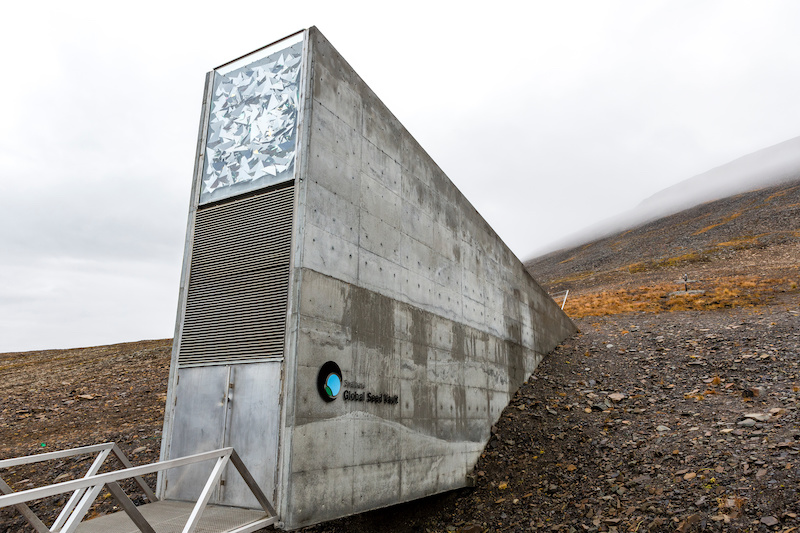
The Svalbard Global Seed Vault in Norway is located about 800 miles beyond the Arctic Circle
The Svalbard Global Seed Vault in Norway is “the backup insurance policy for all the seed banks worldwide,” said its founder, Cary Fowler. The Vault, which stores 500 million seeds, is naturally three to four degrees below zero Fahrenheit. “The Seed Vault could preserve most major food crops’ seeds for hundreds of years. Some, including those of important grains, could remain viable for thousands of years,” Fowler wrote in The Global Crop Diversity Trust paper.
National seed banks monitor their supply constantly; Fowler says, “When they see that a seed sample is declining in its viability, they will take some seeds out, grow them in the real world, and multiply them.”
For the home gardener, seed viability starts with where you get your seeds. According to the California Department of Food and Agriculture, “Poor quality seeds can cost farmers and home gardeners alike considerable amounts of time, money, and resources, by way of reduced yields, poor crop quality, contamination by weeds or other unwanted species.”
Seed Labels are actually regulated. According to the California Seed Law (Section 52288, California Food and Agricultural Code), general label requirements must include a myriad of information, including a viability assurance statement. Seed labels must include sell-by and use-before dates.
Janet Miller, Garden Project Lead at the UC Master Gardener Program of Contra Costa County, said, “I use 25 different vendors for the Garden and the Great Tomato Plant Sale. Reputable seed companies are so important.” She looks for seeds that are 100% organic and vendors that test for disease and germination rates.

Germinating seeds on a damp paper towel
For Miller, this is essential. “I really need a reliable germination rate. For people at home, there’s a test you can do. Put a few seeds in a damp paper towel inside a zip-lock bag. It’s an easy way to germinate seeds.” The test result also determines the seed germination rate as a percentage. Use this calculation to determine seed germination rate:
(Number of seeds sprouted X 100) / Total number of seeds tested = Germination rate%
Example: (17 seeds sprouted X 100) / 20 seeds tested = 85% germination rate
This test is beneficial if you have saved seeds from your garden or have old seeds. “Some seeds have a shelf life of just a year, like onions or parsnips,” Miller said. “Others, like tomatoes, can go 3- to 4-years. In my home garden, I’ve used 20-year-old seeds.”
And just like the Svalbard Seed Vault, how you store your seed is essential. According to Illinois Extension University of Illinois Urbana Champaign, “Seeds need to be kept dry and cool. The most important factors in seed storage are seed moisture and storage temperature. The drier the seeds at time of storage, the longer they can be stored. Store in low humidity and low temperature, below 45°F (15 °C). Storing in a sealed container, such as a jar or bag, in a refrigerator is recommended. If you do not have room in a refrigerator, just keep the seeds cool and dry.” A simple rule of thumb is that the sum of the temperature (degrees F) and percent relative humidity should be less than 100.
Of course, some seeds like lambsquarters seem to be viable for decades. Even more amazing, though, is a marble-size lotus seed that lay dormant in a Manchurian dry lakebed for over 12 centuries is the oldest living seed ever germinated and could shed new light on the aging process, UCLA scientists said.
"A little seed that slept for more than 1,000 years sprouted in four days just like its modern sibling," said plant physiologist Jane Shen-Miller. "It was there already when Marco Polo came to China in the 13th century," she said. "It has a powerful system to resist stress, drought, radiation. Now we have to study how it can maintain itself for this long period."
Shen-Miller was given seven of the ancient lotus seeds in 1982 by the Beijing Institute of Botany. Curious about their viability, she attempted to germinate four of them in 1983, getting three to sprout in the usual four-day germination period. She then had the sprouts carbon dated, a process that killed the plants. But to Shen-Miller's astonishment, the process revealed that they were 1,288 and 684 years old.
An OLLI member since 2017, Simone Adair is also a Rosie the Riveter docent, a voracious reader with books in every room and on every device, a longtime Board Member of a running club, a photographer, an editor, and, believe it or not, a LEGO builder (!) in her nearly non-existent free time.
This piece originally appeared in The Latest Dirt by the UC Master Gardener Program of Contra Costa County.